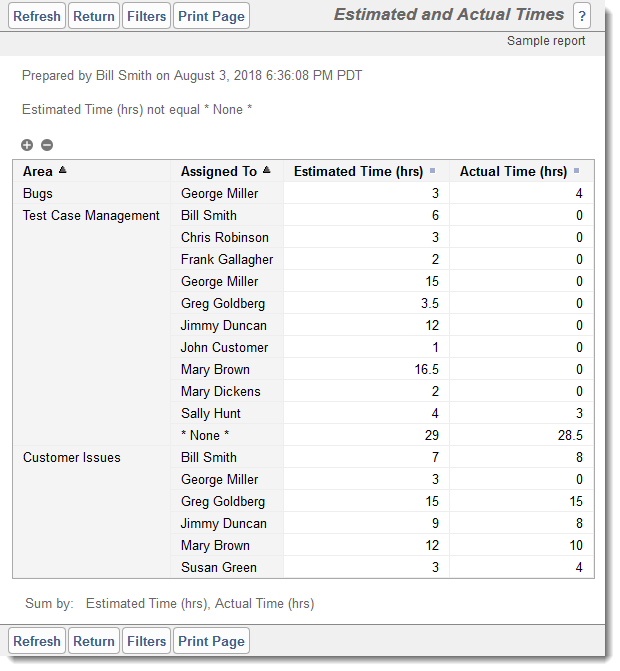Summary Reports
When selected, this action creates a report where ExtraView will provide a count of the number of issues for different fields. Summary reports can be saved as personal or shared reports. Examples include:
- A breakdown of how many issues have been fixed by each engineer in a given period
- The number of issues for each status, broken down by owner
- A breakdown by severity level of all open issues in the system
Using Summary reports, project or area managers can have a snapshot, at any time of the current overall project status. This sort of information is invaluable for producing internal status reports that are backed by real data.
You are able to select from any fields to which you have read permission, and which are able to be summarized. List values are those which are most commonly summarized. To prepare a new Summary report, choose the Create New Summary Report option. The screen presented to you will be similar to the following:
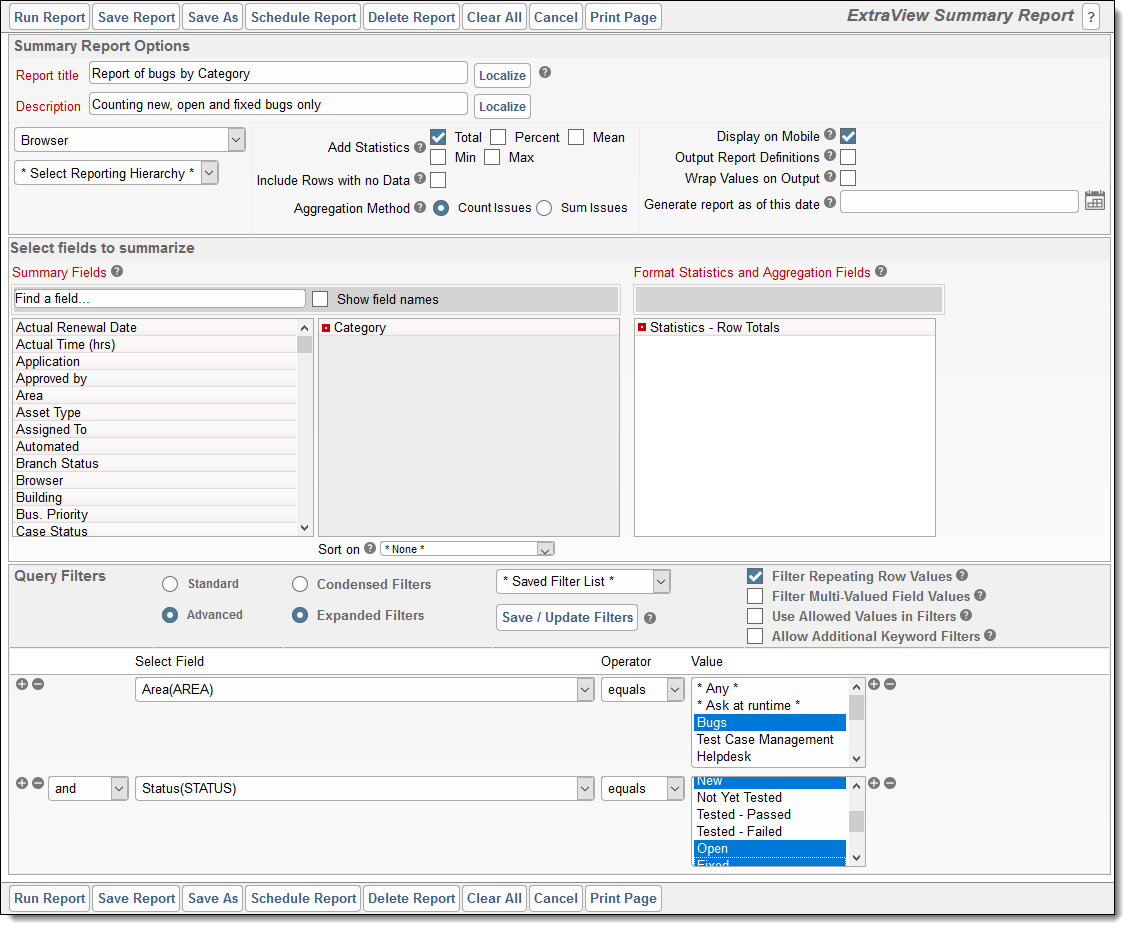
Creating a new summary report
Options
- There is a button to the right of the Report Title that appears when you are editing an existing report. When you place your mouse over this button, you will see who created the report, who last updated the report and the dates when these actions occured. This is most useful for managing shared reports
- There is an option in the preparation of Summary Reports, to Add Statistics to Report. The default option is to display the Total count. You can also elect to display the Percentages, Mean, Minimum, Maximum of the issues generated on the report
- The option Include Rows with no Data allows you to include rows within the results that had no results. Although this is not normally useful, consider the use case where you want to use the report as a target for issues that are going to be dropped on the report. Including zero rows on the report allows you to drop issues onto reports that have no value up to the time you drop the issues
- The Aggregation Method allows you to either produce a summary report that counts the number of issues within each row of the report, or accumulates the total of one or more numeric fields within the row of the report. If you choose to Sum Issues, then a list of all the numeric fields appears. Choose the fields you want to display and total on the report output
- The Add Statistics checkbox options allow you to add a number of different statistics – totals, percentages, means, minimums and maximums to the report output
- For each of the statistics selected, you may apply conditional formatting to the report out. This is fully explained here
- The Display on Mobile button will allow the report to appear on a mobile phone or tablet
- The Output Report Definition button places the options and filters used in the production of the report at the end of the output
- The option to Wrap Values on Output changes the default presentation of values within fields. The default presentation is that the values are displayed on a single line without line breaks, even though the value contains more than one word. If you enable this option, the text values used as row headings will be wrapped. This is useful if you are summarizing long text values. This is not a frequent use case, but when needed, this option improves the readability of the report
- If your administrator has enabled the option that allows you to search for users that have been disabled, you will see a checkbox option that allows you to Show Inactive Users. When you click in the checkbox, the screen will refresh and all user lists will show inactive as well as active users. Note that this option only works with the Standard Query screen, and does not work with the Advanced Query screen.
Selecting columns to summarize and display
- Select the columns that you require on your report, by double-clicking on each field name. If you want to alter the order of the fields being summarized on the report, you can click on a field in the right-hand box and drag it to a new position. To remove a field from the report, drag it out of the box
- You can choose from one to ten columns to summarize on a single summary report
- The value columns and the relevant statistical columns may be sorted by clicking on their title
-
Note the red button to the left of the fields that you have selected to summarize. Right-click on this and a small window will appear where you can set other options for the field. These options are different according to the display type of the field. They include:
- The ability to display sub-totals for the field
- The ability to select the initial sort order of the field on the report output, ascending or descending. You can also sort by the sub-totals as opposed to sorting by the initial values
- The ability to display an alternative title for the field
- The ability to set the width of the field on the output
- For date fields, you can group the results in a variety of means, for example by week, or by fiscal quarter
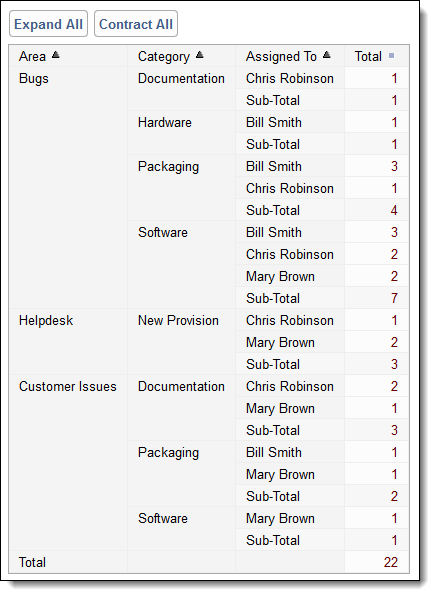
Sample summary report
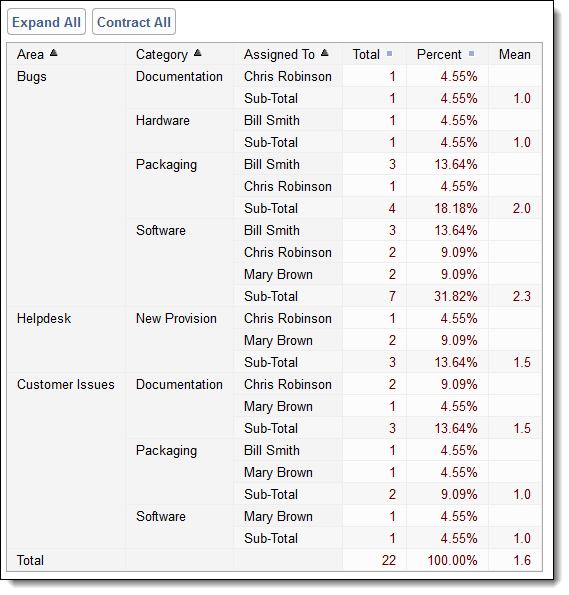
Sample summary report with statistics
Note that you may click on the title value in each section of the report to expand or collapse the values to a single row. You can alos use the buttons at the top of the report for the same function.
Column width on the report output
By default, the width of columns on browser output are not set, and the user’s browser determines the width of each column using its own algorithms. Most of the time, this works well, but there are times when you might want to more accurately fix the width of the Y axis titles being displayed on the output. Right-click on the red button by the field name you selected for the report, and one of the fields allows you to set the width of the column, measured in pixels. This number is approximate, as browsers will sometimes override the number you set, particularly if you are displaying a large number of columns on the screen, relative to the width of the screen. Microsoft Word and PDF column width output are set using the same option. Note that you may also use the report option titled Wrap Titles on Output to assist in controlling the width of columns on the output. When you both set the width of a column and set the Wrap Titles on Output option, the column width setting takes precedence.
Summary Reports and Repeating Records
If you prepare a summary report, and include one or more fields from the repeating record as any the fields that is to be summarized, then it is possible (indeed probable) that an individual record will be summarized into more than one line of the summary report that is displayed.
This works without problem, and you can drill down from an individual line of the report to see the issues that made up the total for the line. The totals for the displayed summary report will be accurate totals of the lines of the report. If you drill down into the total and grand total lines of the displayed summary report, the issues that were included on different lines of the summary report are not repeated as this would be confusing. However, this does lead to the possibility that there will be fewer issues on the drill-down report than appear in the total of the summary report.
For example, you may see a grand total of 135 issues on a summary report, but when you drill down into this total, there may only be 125 issues displayed. This probably indicates that 10 of the issues rightfully appeared in two rows of the summary report.
Summary Reports and Date Fields
Date fields are stored within ExtraView, with the time component accurate to the nearest millisecond. Therefore, if you want to summarize on a date field, you should recognize that the count of issues with the identical date is likely to be one! This may be a little surprising at first, but it is accurate. ExtraView provides alternative methods for summarizing on date fields, so you can answer questions such as “How many issues were opened by each support technician on a given day”? Inbuilt date fields such as “Date Created” have an alternative form, which is the truncated version of the date, i.e. with no time component. If your administrator has given you access to these, then summarizing on this will give a total account within a day. Also, if your administrator configured a date field such that the time component is ignored, then the fields will summarize by the complete day.
If you summarize on a normal date field, the behavior also depends on your personal time format, stored within your personal information. If you have a date format that includes the time within the day, the report will most likely show you a single row for each date entry, with a count of 1. The date displayed on each row will show the time. If your personal date format does not include time, then all the date values are consolidated onto a single label for all the rows of the report, and you will still see one row for each date within the report.
Displaying Only the Top Summarized Results
It can be useful when displaying a summary report to only display the most significant results. For example, a summary report may return 100 rows, but you might only be interested in the ten rows with the highest values. To achieve this, there is filter that is normally used in conjunction with the advanced query mode, titled Top-n rank filter. For the above example, if you set the filter to Top-n rank filter less than or equal to 10, then only the ten highest values will be displayed. If you set the filter to be Top-n rank filter equal to 3 only the third highest value will be displayed. If you ask for the top 10 results, and the tenth result has more than a single record with that value, then all results with that value are displayed. This implies that there may be more than 10 results displayed, even though you are interested in the top ten.
Note that this feature is not supported on all databases. If your installation is utilizing MySQL or Apache Derby as its underlying database, then this feature is inoperable.
Hierarchical Summary Reports
If your administrator has defined hierarchies on which you can report, you will see an additional prompt on the report editor screen:
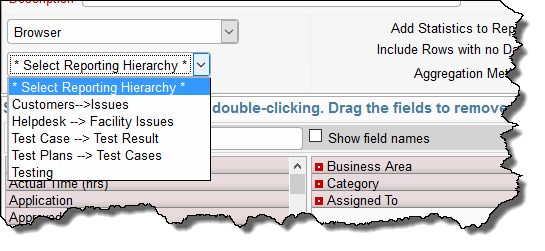
Reporting on hierarchies within summary reports is similar to the way they are defined for column reports. The key difference is that you are only required to select the filters for each level in the hierarchy. These filters will be applied to each level of the hierarchy for the preparation of the data to be placed on the report. The report output will look very similar to a standard summary report, except that the additional filters are applied.
Grouping on Multiple Levels of Hierarchical Filters
This feature produces a standard summary report for the output, but allows you to group the results using filters at each level of the report hierarchies.
- As an example, we will utilize a hierarchy with 3 levels representing an organization that tests software. The organization creates Test Plans and Test Cases. Some subset of the available Test Cases are placed within a Test Plan, in a parent-child relationship. When Test Cases are executed, a Test Result is created as a child relationship of the Test Case
-
To represent this, we have the following reporting hierarchies defined
- Tests, which uses the relationship Test Plans –> Test Cases at the topmost level and Test Cases –> Test Results at the second level
- Test Plans –> Test Cases as a single-level reporting hierarchy
- Test Cases –> Test Results as a single-level reporting hierarchy
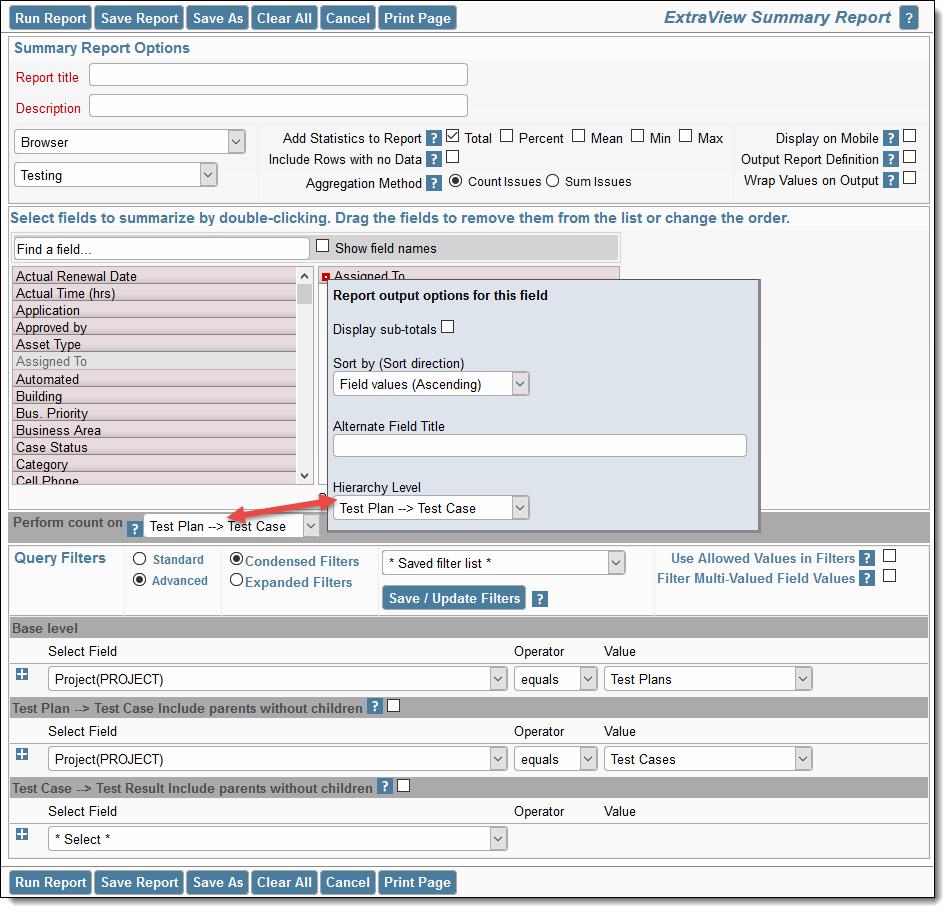
To prepare and run a summary report that groups on multiple levels of hierarchical filters, perform the following steps:
- Create a new summary report
- Select Condensed Query Filters
- Select Advanced Query Screen
- Select the report hierarchy titled Tests
- Select Assigned To as the field to summarize and group by. You group by this field by right-clicking on the red button by the field and selecting Test Plan –>Test Case as the hierarchy level
- Beneath the field list, you see the Perform count on select list. Again, select the Test Plan –> Test Case entry. The important point is that this is the same hierarchy level that you chose in the last step
- Choose the base level query filters. E.g. select the filter PROJECT = Test Plans for the base level
- For the Test Plan –> Test Case level of the hierarchical filters, select the filter PROJECT = Test Cases
- For the Test Case –> Test Result level of the hierarchical filters, select the filter PROJECT = Test Results
- Run the report.
Summarizing Multiple Fields on a Single Report
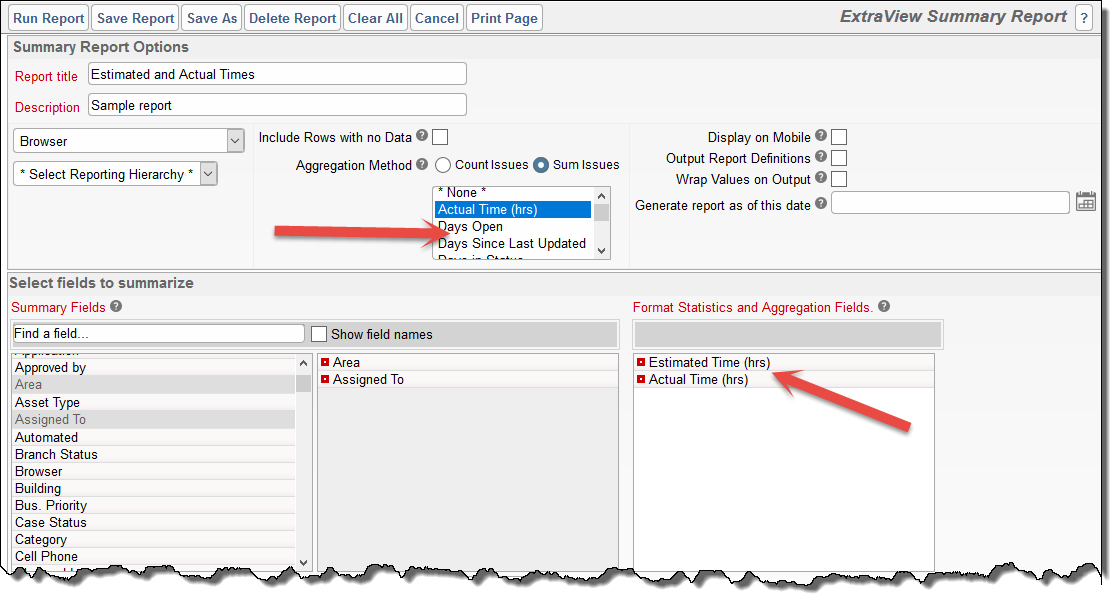
This variation of a summary report allows you to sum multiple fields on a single summary report. You may choose multiple numeric fields from the list that appears when you select to Sum issues. These fields are summed on the report output. Additionally, you can determine the order of the fields appearing on the output, by dragging and dropping the fields into the order you desire within the Format Statistics and Aggregation Fields list.
